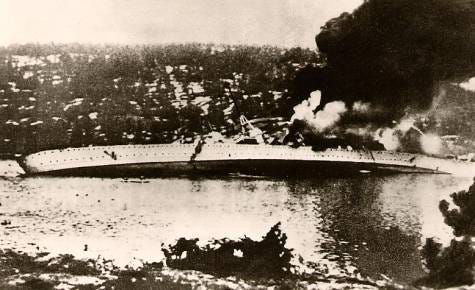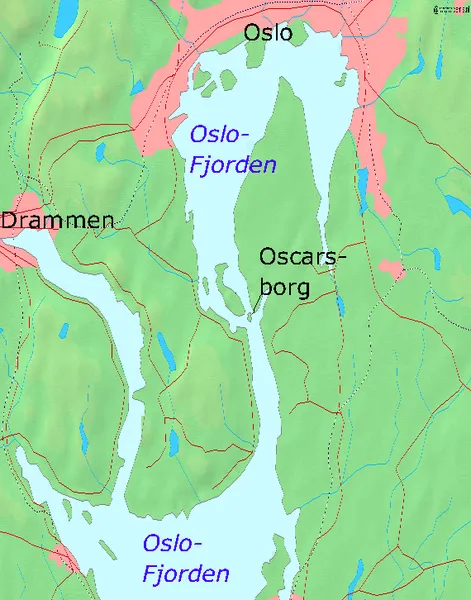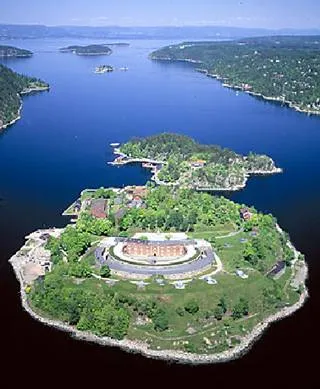
During the night (i.e., the early morning hours) of April 9, 1940 — 84 years ago today —
 |
| Distances from Berlin to neighboring Denmark and to Norway |
Back to 1940. The direct neighbor of Germany, the tiny flat nation of Denmark, fell only after a few hours. But much further away, the far larger Scandinavian country of Norway, with fjords and mountains and other natural defences, had time — as Commander Salamander has recounted (mange takk til Glenn Reynolds) — to organize a defense as well as the evacuation of Oslo's VIPs, thanks to the Oskarsborg fortress, which managed to sink Germany's most modern battleship as, in the middle of the night, the German fleet attempted to sail up the Oslofjord (120 km in length!) past it in the dark and in total silence with all lights off. This stratagem was unsuccessful, as the fortress and other artillery batteries opened fire. Seeing the Blücher torpedoed and sink under the chilly waters of Drøbak Sound, the rest of the German ships made the wise decision to discontinue the attack.

What I'm not sure is clear to many readers is that Oskarsborg's torpedo battery was not directed head-on at (real or would-be) invaders;
 |
| The lengthy Oslo Fjord |
To explain the photos below, you need to know about a familiar Danish pastime: A very popular weekend trip Danish tourists take is the Oslo vacation.
 |
| Copenhagen to Oslo and back |
The photos below come from two trips to and from Oslo (four sails in all), one in September, one the following January. You will excuse a couple of personal and irrelevant photos…
 |
| The guns of the Oskarsborg Fortress can be seen in white |
 |
| Close-up of the Oslo Fjord fortress: four cannon visible, the one furthest to the left in profile |
 |
| A smaller island to the North (tiny bridge straight above my left wrist) is actually linked to fort's main island |
 |
| As the fjord grows narrower, another ferry appears behind us |
 |
| Still followed by another ferry in the distance |
 |
| The width of the fjord tightens considerably |
 |
| Looking over the fjord from its northernmost point, Oslo's Akershus Slott castle |
 |
| Only in Scandinavia: Kondomeriet — the condom boutique on Oslo's Karl Johans Gate (in Norwegian, "Gate" does not mean gate but street) |
 |
| Deciding what, if anything, to buy |
 |
| Good to have a jacuzzi to yourself |
 |
| At the entrance to the fjord, the latter is still wide open |
 |
| Gorgeous sunset on the way home to Copenhagen |
 |
| Man-spreading in the empty jacuzzi |
 |
| Sailing from and (here) back to Copenhagen, the ferry inevitably sails by Hamlet's Elsinore castle, Kronborg |
Other items of interest: the kings of Denmark and Norway were brothers. Only 35 years
earlier, Norway had established its independence from Sweden and the newly-(re)born kingdom
asked the younger brother of Denmark's crown prince Christian to accept the nation's crown. Prince
Carl accepted, and became king under the name of Haakon VII (In the Norwegian movie linked by Cdr Salamander, The King's Choice, all the characters (including the king's son and heir, Prince Olav) are played by Norwegian actors (while the Germans are played by Germans), except the king himself, who is played by a Danish actor, given that Haakon VII never lost his Danish accent).
In that perspective, in the early 1930s, the two brothers almost had no choice but to go to war with each other. Greenland had always been part of Denmark, but Norway (who, for much of her history had been part of Sweden or Denmark) decided that part of the largest island on the planet ought to be called Erik the Red's Land (after the father of the Viking who discovered America) and belonged to Oslo. The issue was eventually resolved by jaw-jawing, by deciding the case at the Permanent Court of International Justice — to Denmark's satisfaction.
Speaking of Greenland, and of World War II, after Denmark was occupied on April 9, 1940, the Danish ambassador to the United States, Henrik Kauffmann, eventually decided to go against the (now-forced-to-cooperate-with-the-Nazis) government in Copenhagen, declared his embassy "independent", and, in that perspective, invited American troops to occupy the island so the Germans could not do so. This has led to another recent film, the Danish production of Vores mand i Amerika (title brilliantly translated as The Good Traitor, as Kauffmann and the Greenland governors were condemned for treason and thus condemned in absentia to death. (Meanwhile, another island in the Atlantic, Iceland, at the time also Danish, was occupied by British forces.) In one 1942 issue of the National Geographic, one of the governors of Iceland welcomes warships of the U.S. Navy to Godthaab (Nuuk). The name of the governor? Aksel Svane — the cousin of my grand-father.

Finally, Churchill was always skeptical of Denmark's reliability as an allied nation, given the speed with which King Christian X (remember, Haakon's elder brother) announced the kingdom's surrender. At least, until the force of the resistance groups to the Germans started growing. Interestingly, Denmark could also have sunk a German troop ship likewise sailing in total silence with all lights off in the dark through Copenhagen on April 9 and thus immediately established its credentials as a fighting or at least a resisting nation. But the guns at the Kastellet were not loaded. His opinion of Denmark was elevated when the Danish authorities learned of the Germans' 1943 decision to disarm the Danish military, and the Danish fleet made the decision to sail for allied or neutral ports or to scuttle their warships.





1 comment:
Nice take on the engagement.
https://cdrsalamander.substack.com/p/fullbore-friday-851
Post a Comment